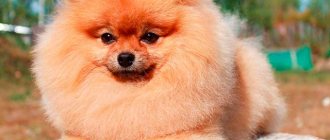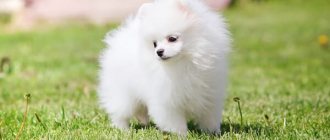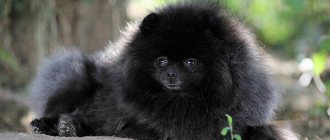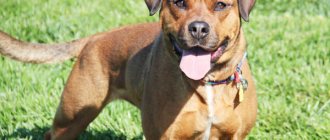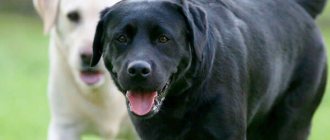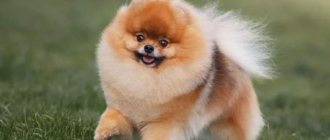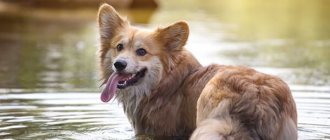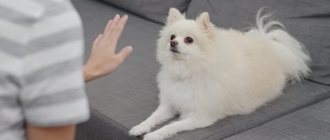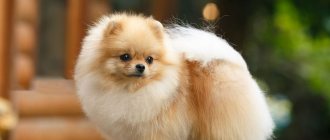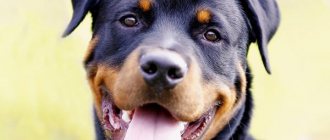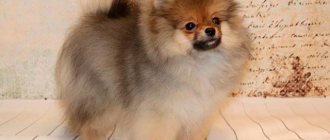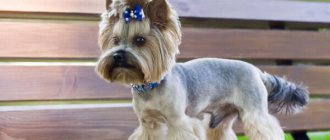Miniature Spitz dogs are popular all over the world today. People appreciate them for their beautiful appearance, varied colors, perky character, and small size, which allows them to be kept in any room. These are the best companions for children, adults or the elderly. The Miniature Spitz loves movement, human attention and travel. Caring for him is not a hassle; he is not picky about feeding, as he has a good appetite.
Today, two varieties of Miniature Spitz have been bred - the bear and fox species. The thick fur of the former makes them look like bear cubs, and the upturned muzzle and slightly slanted eyes of the latter resemble a fox. Further in the article there is a comparison and differences between German and Pomeranian Spitz, what are the features of care, feeding and selection of individuals of the two subspecies.
Origin of both species
Spitz is bred naturally. It appeared in the Stone Age, after being tamed by people, it was used for hunting and to protect herds and pastures. Peat and pile dogs are considered the ancestors. The ancient dog survived in different climatic conditions: natural selection left the strongest and most resilient individuals.
The ancestors of the modern German Spitz were superior to it in body size. They were kept by poor people for hunting and guarding their flocks.
The appearance and intelligence of animals attracted the attention of German aristocrats. The royals wanted to reduce them: to turn large and strong dogs into perky dogs that were comfortable for the home. Breeders began to breed miniature pets.
The dog became very popular in Victorian England. The Pomeranian began to be called so from the name of the province from where it came to the English aristocrats.
Recommendations for breeding activities
In Canada, England and the USA, only documentation of the pet's breeding affiliation is required for breeding work. In other countries, dogs without pedigrees and high scores from exhibitions should not participate in breeding.
Tips for choosing
- You only need to purchase an animal from a nursery. This guarantees that the selected dog will not be replaced by other breeds.
- Familiarization with the pedigree of the parents of the selected Pomeranian puppy that the breeder has.
- Availability of documentation on flea treatments for the small furry creature and vaccinations required by the animal’s age.
The differences between the Pomeranian and the German Spitz are significant. If you need a companion who fully participates in active walks, it is better to choose a German. If you need a pet that you want to take care of a lot, then the Pomeranian will be an excellent option.
What is the difference between a Pomeranian and a German Spitz?
The differences between a Pomeranian and a regular Spitz are:
- Skull shape.
- Number of teeth.
- Body size.
- Positioning of the front paws.
- Tail shape.
- Color.
- Breeding method.
The American Kennel Club prescribes separate standards for each breed. In Russia, the orange is classified as a German subspecies.
Appearance and coat color
Dogs differ in body shape. The German's body is elongated and graceful, resembling a rectangle. The Pomeranian looks dense and well-fed, with a square body. The most accurate comparison of this representative of the breed is its resemblance to a bear cub.
Typical German colors are:
- black;
- brown;
- orange;
- white without yellowness;
- zonal gray.
The hairs are silvery at the top, turning black at the ends.
Among the acceptable colors of this subspecies are:
- Cream.
- Creamy sable.
- Red sable.
- Black and tan.
The listed colors should not contain white inclusions.
The orange has the following standard colors:
- orange;
- ginger;
- white;
- black and tan;
- blue;
- blue and tan;
- cream;
- chocolate.
The pet also comes in two colors.
Dimensions
The Fédération Cynologique Internationale distinguishes 5 types of dogs based on height:
- Keeshond - has a height at the withers from 43 to 55 cm.
- Grossspitz (large) - with a height of 42 to 50 cm at the withers.
- Mittelspitz (medium) – from 30 to 38 cm at the withers.
- Kleinspitz (small) - has from 23 to 29 cm at the withers.
- Miniature Spitz (dwarf) - within 18-22 cm at the withers.
A pet with withers below 18 cm is considered a plembrace.
The differences lie in the weight of the representatives of the breed. Varieties of German Spitz weigh:
- Wolfspitz - 20-28 kg;
- Grossspitz – 13 kg;
- Middle Spitz - 11 kg;
- Kleinspitz - 8-10 kg.
The standard weight of a Pomeranian Spitz is from 2 to 4.5 kg.
Character
The difference between animals is visible in their behavior. The Pomeranian is an impulsive dog. He is always on the move and loves active games. Its peculiarity is rapid adaptation to change. It is recommended to have an animal for people who travel frequently. Spitz is distrustful of strangers. He is stubborn towards his owner and strives to dominate. The animal finds it difficult to get along with other dogs or pets, so it will openly express dissatisfaction. Otherwise, the Pomeranian is a faithful family friend.
Unlike his relatives, the German is a model of balance: ancient roots make themselves felt, when a dog helped a person in carrying out his everyday routine. He is loyal, easy to train, serves as a watchman, notifying of strangers with a loud and piercing bark. If you raise your pet correctly, he will speak on time and on command.
The German Spitz is active and mobile, but in moderation: if the owner is busy, the dog will not impose itself. He knows a sense of proportion. The only thing the animal will not put up with is the presence of strangers in the house.
Differences in maintenance and care
Both species are domestic animals, so outdoor living is not for them. They need regular exercise to maintain normal physical shape. The life expectancy of Spitz dogs reaches 15 years.
You can care for a Pomeranian and a German in the same way. The difference is the attention to the coat, especially in the Pomeranian. The animal has a thick undercoat that needs to be brushed every day with a soft brush. The tool massages the skin and does not pull out hairs, so your orange will not look bald. Antistatic agents or conditioners are used to keep the fur smooth. The dog is groomed so that it looks like a bear cub or lion cub in order to perform at exhibitions. For hygiene purposes, hair is removed from under the tail, around the anus and from the ears.
It is enough to brush a German Spitz twice a week; he gets by without a haircut. Animals of both species are bathed to the extent of contamination with a special shampoo for representatives of this species of four-legged animals. You cannot cut off the entire coat of a Spitz - in Germans and Pomeranians it is slowly restored due to the thick second layer. After washing, animals must be dried with a hairdryer to preserve the structure of the abundant fur.
The German type Spitz has a greater health reserve: this is due to its herding and guarding past, when animals served people regardless of the weather and season. The Pomeranian species cannot be compared because it is an ornamental animal.
Feeding: which Spitz is more picky?
Animals have a fast metabolism, so their appetite is high. Owners need to take this into account and not overfeed their Spitz. For internal organs to function properly and appearance to be attractive, pets need vitamins. Light-colored dogs are allergic to chicken, wheat and other foods that must be excluded from the diet.
Head
In the description of the German and Pomeranian Spitz breeds, there is also a difference in the size of the dog’s head. If it is difficult to distinguish a German from an Pomeranian by height and color, the differences in the structure of the heads of representatives of these breeds are obvious.
Pomeranian-type dogs have small, pointed and fairly wide-set ears. Their muzzle is short with a clear transition to the forehead. Outwardly, they vaguely resemble small bear cubs. The fur on the head of the Pomeranian is similar in shape to a hat. Thick fur is also present in the cheek area.
German Spitz dogs do not have such a cap, and their narrow muzzle (similar to a fox) is covered with smooth hair. The forehead line of the Germans is smoothed, gradually moving towards the muzzle. Ears with sharp tips are set close to each other.
What are the similarities between Pomeranian and German Spitz?
The animals are similar in appearance and character. The German became the basis for the breeding of the Pomeranian Spitz. To get a toy dog, breeders made him smaller and crossed him with other dwarf dogs.
Both animals are active and mobile. They need to move a lot and love to play. The Germans, like their relatives, are manipulators who will get what they want from the owner. Both Spitz dogs tend to be dominant. You should not be deceived by the dog’s miniature appearance: he needs training, otherwise he will begin to feel like the head of the house.
Both Spitz dogs are wary of strangers - people and animals. They will not be the first to attack, but in case of third-party aggression they will stand up for themselves and for the owner.
Comparison of breeds by other criteria
Table of differences between a German Spitz and a Pomeranian on a five-point scale.
| Indicators | German Spitz | Pomeranian Spitz |
| Health | 4 | 3,5 |
| Abundance of shedding | 5 | 4 |
| Attachment to family, home | 5 | 4 |
| Attitude towards strangers | 2 | 3 |
| Attitude towards children and other animals | 5 | 4,5 |
| Guard qualities | 4 | 2,5 |
| Dog bodyguard | 4 | 2,5 |
| Activity | 4 | 3,5 |
| Training issues | 4 | 4,5 |
| Price | From 20 thousand rubles. up to 45 thousand rubles. | From 15 thousand rubles. up to 120 thousand rubles. |
Spitz dogs vary greatly in cost. On the one hand, this is due to the low fertility of the breeds, on the other, Pomeranians from the very beginning positioned themselves as an ornamental breed, so it is not surprising that its price is obviously higher than the cost of its relatives.
How to distinguish a German Spitz puppy from a Pomeranian?
Up to three months, pets are indistinguishable from each other in physique and appearance. It is difficult to predict what their height and weight will be. At 3 months, a Pomeranian should not weigh more than 1 kg. Heavier animals are classified as small Spitz.
To choose dwarf individuals rather than Spitz of other subspecies, you should buy a few mature Germans or their Pomeranian relatives. Molting also helps to make sure that the choice is correct: during this period, differences in physique are more noticeable.
Factor differences
Many people believe that the division of Spitz into German and Pomeranian is based on their size. However, in addition to this, their exterior is also significantly different.
In order to be able to distinguish between these two breeds, you need to know how the Pomeranian Spitz differs from the German Spitz in the following parameters:
- origin;
- Name;
- size;
- head shape;
- wool cover;
- color;
- tail;
- front legs;
- number of teeth.
Based on knowledge of these differences, you can easily determine which Spitz is Pomeranian and which is German.
Who is better to choose?
Which type of dwarf dog to choose depends on the purpose for which a person is going to have a four-legged friend.
The animals differ from each other in origin and appearance, but in character they are similar: both are equally friendly, perky, cheerful and easygoing with children and adults. If you raise them from early childhood with other pets, the dogs will be friends with them too.
Dogs are suitable for active people who spend a lot of time on the move. They are companions who require human presence, attention and communication. If you ignore your pets, they become willful and aggressive.
The German Spitz and its subspecies are well trained. From the first you can create an effective watchman, and the second will become an indispensable companion - this is the difference between animals. The Miniature Spitz is less hardy compared to its German relative, and its health is not as good.
The main differences between dogs are in appearance.
Wool
The wool of representatives of these breeds also has its own characteristics. In particular, the structure is different, which can be easily determined by running your hand over it.
Representatives of the Pomeranian type of Spitz have a double coat. There is either no guard hair or very little guard hair. The structure of the wool resembles springs. The undercoat of these dogs is long and soft, requiring special care. It feels like a lump of cotton wool to the touch. It needs to be trimmed regularly, thereby giving it a certain shape. In addition, Pomeranians need frequent bathing.
Germans, like Pomeranians, have a coat consisting of guard hair and undercoat. However, their guard hairs are straight and longer, making it close to the dog’s body. Its ability to secrete secretions helps in cleaning the coat. Their undercoat is short and wavy, so they do not require as much grooming as Pomeranians.
You can clearly see in the photo how the Pomeranian Spitz differs from the German Spitz in its coat.
Questions and answers
Which Spitz is smaller - German or Pomeranian?
Both species are of the same height, which ranges from 18 to 22 cm at the withers. If the height of the animal is less than 18 cm, it has diseases. Pets weigh from 2 to 4.5 kg.
Differences between Pomeranian and German Spitz
Individuals of the two varieties can be distinguished by their physique, character and appearance. If you compare dwarf animals, they are both perky, active, and love the company of adults or children. At the same time, the Miniature Spitz from Germany is more balanced, while its relative from Pomerania is impulsive. The Pomeranian is an excellent companion, and the German is also a good watchman if you train him to give the “voice” command when necessary. The first type of dog is more finicky in care and feeding: the thick coat must be treated every day with a soft brush and washed regularly with a special shampoo. They need to be cut regularly to give them that characteristic teddy bear look. The German Miniature Spitz is easier to care for. He is not cut, but his coat is groomed with a brush twice a week. He is in better health. In puppyhood, it is impossible to distinguish between individuals of the two varieties until they are 3 months old. It is recommended to buy teenagers: their weight at this time should be less than 1 kg. This way the owner can make sure that the breeder sold him a real Miniature Spitz.
Story
The common ancestors of all Spitz dogs are considered to be the peat dog, a fossil animal of the Stone Age, and the pile dog, which descended from it, who lived a little later. And the Spitz themselves are considered one of the oldest breeds in Europe. It is known for certain that they served people since the 14th century. Then one of the features of this breed was widely used - an alarming ringing bark. Thanks to this, Spitz were known as good watchdogs and they began to be used as assistants to shepherds and farmers.
The reign of Queen Victoria marked a new stage in the history of the breed. Spitz dogs are gaining popularity at court and in the houses of the nobility. Work begins on developing smaller breed forms and improving standards. Clubs for Spitz lovers, stud books and the first exhibitions with their participation are beginning to appear throughout Europe.
The division of Spitz into groups occurred only at the end of the 19th century, at which time standards were adopted, which were clarified several times. Today's Mittelspitz is included in the list of 349 breeds recognized by the International Canine Federation.
Medium German Spitz
Tail
Another difference between the breeds is the tail. The German variety of Spitz has a tail that can curl into one or two rings. In this case, the tail of animals is always located on top of the back.
The Pomeranian breed, distinguished from other Spitz dogs by its small size and toy appearance, has a straight tail. At the same time, it always lies on the surface of the back.
Now it’s clear how to distinguish one breed from another. After all, for each parameter, the breeds have, although not always obvious, differences.
Nutrition
The diet of miniature spitzes must be properly structured; it is this that affects the health of the pet. An adult dog can be fed using one of three methods:
- dry food;
- natural nutrition;
- combined method (natural food and dry food).
Only premium or super-premium food is purchased for animals. Preference is given to food designed specifically for Spitz or toy breeds. Such products contain ideally balanced nutrients and minerals and contain essential vitamins. Popular food brands: Eukanuba, Natural, Acana, Husse and others.
Some owners soak dry food in water in advance. These actions are acceptable, but the food must be diluted in such a proportion that the dog eats it in one sitting. Anything left over should be thrown away. Leftover pieces of food quickly deteriorate and can negatively affect your pet’s health.
Natural food is food not from the owner’s table, but prepared products. Animals will benefit from eating the following foods.
- Lean meats. It can be beef, poultry, beef or chicken liver, heart.
- Give your pet a boiled egg once a day.
- Boiled porridges made from cereals are recommended, with the exception of pearl barley, millet, and semolina. These cereals cause bloating and colic due to poor digestion by the dog’s body.
- The diet includes fruits and vegetables. Potatoes and legumes should not be given.
- The use of fish and seafood is acceptable. Any fish is served boiled, without bones.
- Fermented milk products must be pasteurized. No raw milk.
It is prohibited to feed the animal the following products:
- confectionery products, various buns, baked goods, sweets, any flour products;
- spices, seasonings;
- food with preservatives;
- salted, smoked, pickled, fatty products;
- sausages.
You cannot change the animal’s diet suddenly or frequently. Dietary changes should occur smoothly; within one week it is recommended to introduce or change one type of product. With a combined type of nutrition, natural food and dry food are not consumed at one meal. The diet is structured as follows. In the morning, the animal is given dry food and clean water. For lunch, the pet consumes boiled lean meat or fish products. In the evening he receives a fermented milk product, for example, cottage cheese.
The animal does not need a variety of dishes; one brand of dry food, two types of meat or fish, two or one types of cereals and a couple of vegetables will be enough. The animal must not be overfed. It is necessary to decide on the norm of food consumed and give your pet the same amount of food all the time. The frequency of meals can be divided into larger quantities, but the mass of food consumed should remain the same. Experts recommend the following picture of food consumption. Puppies up to two months eat 6 times a day. From two months - 5 times. From 6 months - 3-4 times. Over 8 months, the animal eats 2-3 times a day, most often the dog is fed in the morning and evening. It is advisable to feed your pet at the same hours.
What do you need to know when choosing a puppy?
If you want to purchase a purebred dog for breeding, you need to follow these rules:
- Apply for a dog to a kennel with a good reputation (it must be registered with the FCI, otherwise we cannot cooperate with it). There is no need to buy a puppy from your own hands - there is a very high risk of taking a rejected or not purebred animal. Also, private individuals are more likely to have sick pets that suffer from hereditary diseases.
- Request parent's pedigree. You should have it on hand if you plan to participate in exhibitions or breeding. You will have to refuse to purchase a dog for which there are no documents. If the pedigree records that one of the parents was German and the other was Pomeranian, you can buy a pet - such crossing is allowed. According to the documents, the dog will be designated as a German Spitz.
- Be sure to weigh the baby you choose. Remember that a purebred Pomeranian at three months of age should not weigh more than a kilogram. As for Kleins, they can weigh up to 2 kilograms (provided that the dogs maintain their natural body proportions). If the animal weighs more or less than the specified standard, you cannot buy it. Such a deviation corresponds to health problems or loss of species characteristics as a result of incorrect selection of female and male for crossing.
- Pay special attention to the condition of the puppies. Do not take animals that have been starved, infected with worms, or specially fattened. Firstly, you will not be able to predict what diseases he will develop in the future. Secondly, such weight problems may indicate that the dog does not meet the breed standards, and breeders want to artificially “adjust” it to the desired parameters.
- Read reviews about buying a puppy from your chosen nursery - they can be found on the dog breeders forum. If possible, talk to those people who have managed to acquire a four-legged friend, ask them to send a photo of the pet, talk about its state of health, the intricacies of care, breeding, achievements at exhibitions and competitions. Make sure that the nursery does not deceive people, provides them with the necessary assistance in caring for their pet, and only then agree to the deal. Do not cooperate with dishonest people.
- Be prepared for the Pomeranian's passport to say German Spitz. European nurseries consider this variety as a subspecies of Klein, which is indicated in the documents. It's not a mistake.
Having chosen a specific individual, do not be lazy to study its documents, know what the baby’s parents were sick with (such information should be available), and whether they have genetic defects that are inherited. Only by collecting all the important data about the animal can you buy a dog that will delight you for many years, participate in exhibitions and breedings with representatives of its breed. It is especially important to take into account all the subtleties when choosing a puppy for those who buy it for breeding. If a dog is purchased for the soul, some features that do not correspond to its variety can be neglected.
Differences
Chanterelles have differences from other types.
From bearish
Spitz bears and foxes are not at all similar. Among dwarf oranges, bear cubs are the most popular and are in high demand. Looking at their appearance, you can immediately notice their characteristic features.
- Bears have a disproportionately large head and a flat muzzle. Chanterelles have a small, wedge-shaped head with a cunning elongated nose that matches the proportions of the body.
- The bear's chin is always raised, so it seems that the baby is looking up. In chanterelles, due to their scissor bite, the chin is generally difficult to find.
- The bear's nose is higher than that of a fox's.
- The ears are small, round, as if buried in wool. They are noticeably different from the pointed, protruding ears of a fox cub.
- The bear's fur, unlike the fox's, is short, like that of a plush toy.
- The body of the robust creatures is wide, reminiscent of real bear cubs, which is strikingly different from the graceful body of the chanterelles.
The bear type is so popular with buyers that breeders often sell dogs that do not meet the accepted standard, which must be culled and neutered to prevent the misbreeding from continuing. Deviations from the standard affect the health and longevity of the pet.
From a toy
The Japanese developed the toy Spitz. It is impossible to distinguish it from a soft toy until the dog begins to move. Until recently, this baby's color was exclusively white. Today they are trying to breed dogs with different shades, they already represent the population at exhibitions, but as before, the most expensive representatives of this group are white, their cost ranges from 25 to 40 thousand rubles. If you compare the toy orange with other types of oranges, it will turn out to be more similar to the bear type:
- the muzzle is like that of a bear cub, only even more flattened, the complete opposite of the elongated fox;
- the eyes are further apart from each other than in other types;
- strong, but not as clumsy as bear cubs, and not as graceful as fox cubs;
- the toy appearance is given by unnaturally thick, pleasant-to-touch fur;
- A distinctive feature of the toy type is its incredibly fluffy tail.
